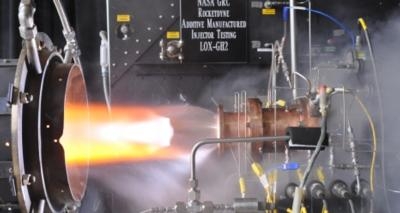Component Produced Through The '3-D Printing' Process
NASA and Aerojet Rocketdyne of West Palm Beach, FL, recently finished testing a rocket engine injector made through additive manufacturing, or 3-D printing. This space technology demonstration may lead to more efficient manufacturing of rocket engines, saving American companies time and money. NASA's Glenn Research Center in Cleveland conducted the successful tests for Aerojet Rocketdyne through a non-reimbursable Space Act Agreement.

A series of firings of a liquid oxygen and gaseous hydrogen rocket injector assembly demonstrated the ability to design, manufacture and test a highly critical rocket engine component using selective laser melting manufacturing technology. Aerojet Rocketdyne designed and fabricated the injector by a method that employs high-powered laser beams to melt and fuse fine metallic powders into three dimensional structures.
"NASA recognizes that on Earth and potentially in space, additive manufacturing can be game-changing for new mission opportunities, significantly reducing production time and cost by 'printing' tools, engine parts or even entire spacecraft," said Michael Gazarik, NASA's associate administrator for space technology in Washington. "3-D manufacturing offers opportunities to optimize the fit, form and delivery systems of materials that will enable our space missions while directly benefiting American businesses here on Earth."
This type of injector manufactured with traditional processes would take more than a year to make but with these new processes it can be produced in less than four months, with a 70 percent reduction in cost.
"Rocket engine components are complex machined pieces that require significant labor and time to produce. The injector is one of the most expensive components of an engine," said Tyler Hickman, who led the testing at Glenn.

Aerojet Rocketdyne's additive manufacturing program manager, Jeff Haynes, said the injector represents a significant advancement in application of additive manufacturing, most often used to make simple brackets and other less critical hardware. "The injector is the heart of a rocket engine and represents a large portion of the resulting cost of these systems. Today, we have the results of a fully additive manufactured rocket injector with a demonstration in a relevant environment." he said.
Glenn and Aerojet Rocketdyne partnered on the project with the Air Force Research Laboratory at Edwards Air Force Base, CA. At the Air Force lab, a unique high-pressure facility provided pre-test data early in the program to give insight into the spray patterns of additively manufactured injector elements.
"Hot fire testing the injector as part of a rocket engine is a significant accomplishment in maturing additive manufacturing for use in rocket engines," said Carol Tolbert, manager of the Manufacturing Innovation Project at Glenn. "These successful tests let us know that we are ready to move on to demonstrate the feasibility of developing full-size, additively manufactured parts."
(Image provided by NASA.)
 NTSB Final Report: Rutan Long-EZ
NTSB Final Report: Rutan Long-EZ ANN FAQ: Turn On Post Notifications
ANN FAQ: Turn On Post Notifications Classic Aero-TV: ICAS Perspectives - Advice for New Air Show Performers
Classic Aero-TV: ICAS Perspectives - Advice for New Air Show Performers ANN's Daily Aero-Linx (06.28.25)
ANN's Daily Aero-Linx (06.28.25) Aero-News: Quote of the Day (06.28.25)
Aero-News: Quote of the Day (06.28.25)




